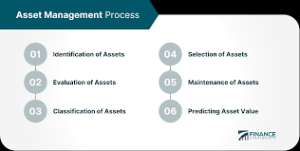Asset Management: The Key to Effective Information Systems Security
Information Systems Security:
Data systems play a critical role in the working of governments and businesses in today’s technology-driven world. These systems cover many assets, including hardware and software, vital for an organization’s smooth operation and success. Nevertheless, managing these assets professionally is critical to ensure their optimum utilization, longevity, and security. This essay discovers the significance of asset management in information systems security, delving into the differentiation between hardware and software assets and why effective asset management is vital for organizations.
Importance of the Asset Management

Asset management refers to the systematic and organized approach of tracking, optimizing, and maintaining an organization’s assets throughout its lifecycle. In the context of information systems, asset management plays a pivotal role for several reasons:
Security: Asset management is implemented in the organization as a primary reason for improving information system security. All assets and associated risks are kept tracked to guarantee proper organization protection.
Cost Efficiency: Efficient asset management enables organizations to make better-informed decisions about hardware and software acquisitions, avoiding unnecessary expenses and optimizing costs.
Compliance and Legal Requirements: Many industries are bound by specific data security and privacy regulations. Asset management aids in adhering to these standards and preventing potential legal liabilities.
Resource Optimization: By knowing the precise inventory of assets, organizations can allocate resources more effectively, preventing over-investing in certain areas and ensuring all purchases are utilized efficiently.
Improved Productivity: Asset management facilitates quicker access to required resources, reducing downtime and increasing overall productivity.
Hardware vs. Software Assets
It is essential to understand the differences between hardware and software assets and the unique challenges associated with each, to manage information systems assets effectively.
Hardware Assets
Hardware assets consist of physical components that constitute an information system. These include computers, network devices, servers, printers, and storage devices. Hardware asset management comprises:
- Inventory Management: Maintaining an up-to-date inventory of all hardware assets, including their specifications, condition, and location.
- Maintenance Scheduling: Implementing consistent maintenance routines to extend the lifespan and performance of hardware assets.
- Security Measures: Physical security measures, such as protecting hardware assets from theft, unauthorized access, or access controls and surveillance.
- Disposal and Recycling: Properly disposing of damaged or outdated hardware in an environmentally friendly manner.
Software Assets
Software assets refer to the intangible components of an information system, including licenses, databases, applications, operating systems, and Software asset management include:
- License Management: Ensuring software is appropriately licensed and compliant with legal requirements.
- Version Control: Keeping track of software versions to identify and fix weaknesses and compatibility issues.
- c. Patch Management: Frequently updating software to address security flaws and improve performance.
- Usage Monitoring: Tracking software usage to identify underutilized or redundant applications.
Information Systems Security
Information systems security is critical to any organization, as it prevents unauthorized access, safeguards sensitive data, and protects against cyber threats. Effective asset management donates expressively to information systems security:
Vulnerability Management: Asset management aids in identifying and prioritizing assets that are vulnerable to security breaches. This knowledge allows organizations to focus on securing critical assets and implementing appropriate security measures.
Incident Response: In a security incident or breach, asset management enables a swift response by providing necessary information about the affected assets, allowing for prompt isolation and resolution.
Access Control: Knowing the particular inventory of hardware and software assets empowers organizations to contrivance robust access controls, guaranteeing that only authorized personnel can interrelate with perilous resources.
Data Protection: Asset management helps identify and secure data stored on various assets, reducing the risk of data leaks or loss.
Conclusion
Asset management is a fundamental aspect of information systems security. Organizations can enhance security, optimize resources, and comply with legal requirements by managing hardware and software assets effectively. Hardware and software assets have distinct management challenges, but both play a vital role in information systems’ overall functioning and security. A proactive approach to asset management ensures that organizations are well-prepared to face emerging security threats and can adapt to technological advancements without compromising data integrity or system reliability. Embracing asset management as a strategic priority is essential for organizations seeking to maintain a secure and efficient information systems environment.
References:
References Part 1. (2021). pp.81–91. doihttps://doi.org/10.1002/9781119070740.refs1.
Strawbridge, M. (2007). Microsoft Office Word 2007 Essential Reference for Power Users. Software Reference.
www.cengage.com. (n.d.). Principles of Information Security, 7th Edition – 9780357506431 – Cengage. [online] Available at: https://www.cengage.com/c/principles-of-information-security-7e-whitman-mattord/9780357506431/





